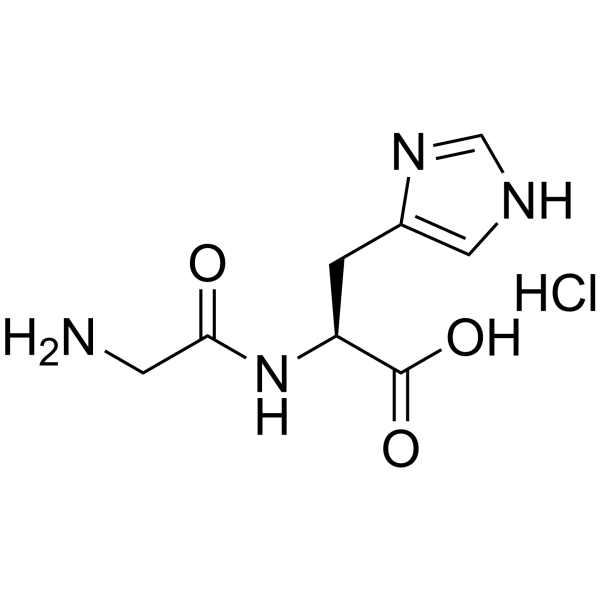H-Gly-His-OH · HCl

H-Gly-His-OH · HCl structure
|
Common Name | H-Gly-His-OH · HCl | ||
|---|---|---|---|---|
| CAS Number | 3486-76-8 | Molecular Weight | 248.66700 | |
| Density | 1.434g/cm3 | Boiling Point | 657.9ºC at 760mmHg | |
| Molecular Formula | C8H13ClN4O3 | Melting Point | N/A | |
| MSDS | Chinese USA | Flash Point | 351.7ºC | |
Use of H-Gly-His-OH · HClGly-His hydrochloride is a Glycine (HY-Y0966) derivative[1]. |
| Name | h-gly-his-oh hcl |
|---|---|
| Synonym | More Synonyms |
| Description | Gly-His hydrochloride is a Glycine (HY-Y0966) derivative[1]. |
|---|---|
| Related Catalog | |
| In Vitro | Amino acids and amino acid derivatives have been commercially used as ergogenic supplements. They influence the secretion of anabolic hormones, supply of fuel during exercise, mental performance during stress related tasks and prevent exercise induced muscle damage. They are recognized to be beneficial as ergogenic dietary substances[1]. |
| References |
| Density | 1.434g/cm3 |
|---|---|
| Boiling Point | 657.9ºC at 760mmHg |
| Molecular Formula | C8H13ClN4O3 |
| Molecular Weight | 248.66700 |
| Flash Point | 351.7ºC |
| Exact Mass | 248.06800 |
| PSA | 121.10000 |
| LogP | 0.37350 |
| Index of Refraction | 1.604 |
| Personal Protective Equipment | Eyeshields;Gloves;type N95 (US);type P1 (EN143) respirator filter |
|---|---|
| RIDADR | NONH for all modes of transport |
| WGK Germany | 3 |
| HS Code | 2933290090 |
| HS Code | 2933290090 |
|---|---|
| Summary | 2933290090. other compounds containing an unfused imidazole ring (whether or not hydrogenated) in the structure. VAT:17.0%. Tax rebate rate:13.0%. . MFN tariff:6.5%. General tariff:20.0% |
|
Effect of carnosine and related compounds on the inactivation of human Cu,Zn-superoxide dismutase by modification of fructose and glycolaldehyde.
Biosci. Biotechnol. Biochem. 66 , 36-43, (2002) Glycolaldehyde, an intermediate of the Maillard reaction, and fructose, which is mainly derived from the polyol pathway, rapidly inactivate human Cu,Zn-superoxide dismutase (SOD) at the physiological ... |
|
|
Reduction of vanadium(V) to vanadium(IV) by NADPH, and vanadium(IV) to vanadium(III) by cysteine methyl ester in the presence of biologically relevant ligands.
Biochim. Biophys. Acta 1770(8) , 1212-8, (2007) To better understand the mechanism of vanadium reduction in ascidians, we examined the reduction of vanadium(V) to vanadium(IV) by NADPH and the reduction of vanadium(IV) to vanadium(III) by L-cystein... |
|
|
A comparative study of complex formation in the reactions of gold(III) with Gly-Gly, Gly-L-Ala and Gly-L-His dipeptides.
Bioorg. Chem. 38(4) , 144-8, (2010) Proton NMR spectroscopy was applied to study the reactions of the dipeptides glycyl-glycine (Gly-Gly) and glycyl-L-alanine (Gly-L-Ala) with hydrogen tetrachloridoaurate(III) (H[AuCl(4)]). All reaction... |
| Glycyl-L-histidine hydrate hydrochloride |
| Gly-His hydrochloride hydrate |
| glycyl-l-histidineHClhydrate |
| Gly-l-His*HCl |
| glycyl-L-histidine hydrochloride |
| glycyl-L-histidine hydrochloride hemihydrate |
| glycyl-L-histidine*HCl |
| Gly-His hydrate hydrochloride |
| GLYCYL-L-HISTIDINE HYDROCHLORIDE MONOHYDRATE |
| H-Gly-His-OH · HCl |

